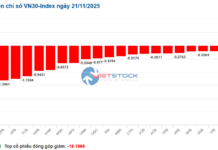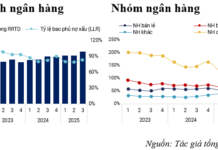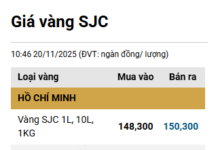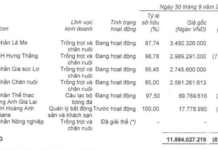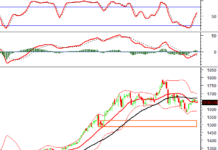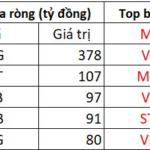
The “buy-on-dip” strategy remains favorable, driven by attractive valuations and anticipated growth narratives from Q4-2025 to 2026. Image: LÊ VŨ |
Fiscal Policy Shift
One of the most significant developments impacting Vietnam’s stock market in the final months of 2025 is the National Assembly session, held from October 20 to December 11, 2025. The session focuses on amending 49 laws and numerous resolutions. Notably, growth-supportive amendments, such as revisions to the Investment Law, Enterprise Law, and a resolution addressing Land Law implementation challenges, are proposed just one year after the law’s enactment. Additionally, regulatory streamlining continues, with increased autonomy granted to government agencies and businesses to expedite policy execution.
During this session, the government presented the 2026-2030 National Financial Plan, marking a strategic shift in fiscal policy. The focus transitions from stability (2021-2025) to growth promotion (2026-2030). The government aims for double-digit economic growth, supported by robust public investment while maintaining fiscal discipline. Despite a significant increase in total investment, the number of projects will be streamlined from approximately 4,652 to under 3,000, indicating larger average project sizes. Investment priorities remain on strategic infrastructure, including transportation, energy, and digital economy. Expanding public-private partnerships (PPPs) in strategic infrastructure projects is expected to play a pivotal role in the upcoming phase. This approach diversifies investor bases and ensures a balance between local autonomy and fiscal transparency. However, success hinges on effective implementation, public investment absorption capacity, and sustainable public debt management, especially amid global volatility.
Buy-on-Dip Strategy
Vietnam’s stock market experienced significant volatility in September and October 2025, marking the deepest correction since April 2025. This was primarily due to profit-taking pressures following a series of positive developments, including the U.S. Federal Reserve’s rate cuts, market upgrade expectations, and strong Q3-2025 earnings. By late October, excluding Vingroup-related stocks, the VN-Index had declined approximately 7% from its early September peak. Foreign investors continued their third consecutive month of net selling, totaling VND 22 trillion, primarily in banking, securities, and real estate sectors, bringing year-to-date net outflows to VND 120 trillion.
|
In the short term, sectors poised for strong Q4-2025 profit growth include materials, real estate, and information technology, while consumer and financial sectors are expected to maintain double-digit growth. |
Market liquidity remained stable in October, with matched order trading values averaging VND 31 trillion per session, flat from the previous month but down 33% from August’s record high. However, average liquidity dropped to VND 25 trillion per session in late October, driven by rising interest rates and capital shifts toward IPOs. Increased derivatives market activity also contributed to heightened volatility in the underlying market.
Margin lending debt surged but remained below regulatory limits. By Q3-2025, total margin debt among monitored securities firms reached a record VND 385 trillion (USD 14.6 billion), up 26.2% quarterly and 63% year-on-year. The margin debt-to-equity ratio rose to 1.16 by September-end, compared to 1.0 in Q2-2025, but remained well below the 2.0 regulatory cap, indicating manageable leverage risks.
In the final months of 2025, the stock market is expected to reflect 2026 prospects, supported by the government’s 10% GDP growth target and ongoing consumer stimulus measures. These positive macroeconomic factors provide a solid foundation for economic growth and investor confidence. In the short term, sectors poised for strong Q4-2025 profit growth include materials, real estate, and information technology, while consumer and financial sectors are expected to maintain double-digit growth.
According to SSI Research, historical data from the past three years suggests that short-term corrections typically end in November, paving the way for year-end market recovery. However, reduced liquidity due to higher interest rates and capital shifts toward IPOs may limit the potential for a strong rebound. In this context, the “buy-on-dip” strategy remains favorable, driven by attractive valuations and anticipated growth narratives from Q4-2025 to 2026.
Valuation-wise, the market’s 2025 projected P/E ratio stands at approximately 13.8 times, near the 10-year average. The 2026 projected P/E is around 12 times, below the long-term average and historical highs (approximately 15 times). This indicates significant upside potential if corporate earnings meet expectations, particularly for fundamentally strong stocks.
Đăng Linh
– 07:00 20/11/2025
Foreign Investors Ease Sell-Off Pace, Counter-Trend with Nearly VND 400 Billion Buy-In on Blue-Chip Stock
Foreign investors narrowed their net selling streak, with a modest net sell of approximately VND 84 billion across the entire market today.
How Record-Breaking Stock Markets Have Fueled Bank Performance
The third quarter of 2025 marks a historic milestone as the VN-Index surpasses its peak, with the banking sector playing an irreplaceable leading role. Interestingly, the vibrant stock market has also delivered a powerful boost to the business operations of banks, particularly those owning securities companies.

